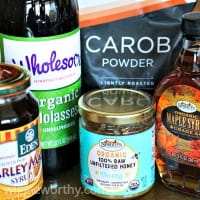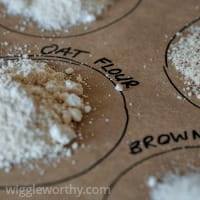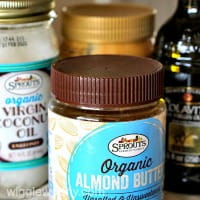Fruits & Vegetables for Dog Treat Recipes
The best fruits and vegetables for dog treat recipes pack a powerful nutritional punch, as well as adding color, flavor, fluid, fiber and a more to your homemade creations.
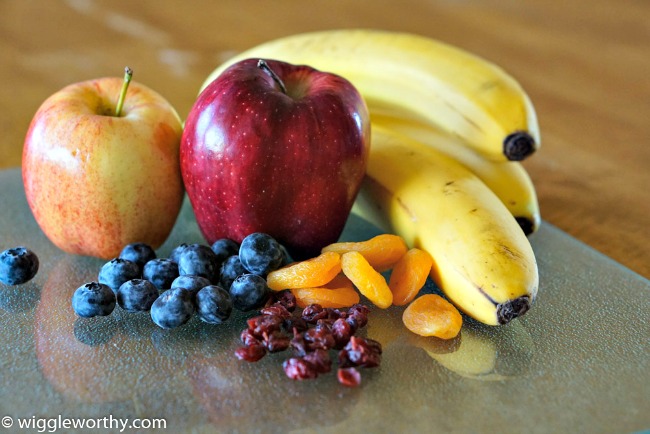
There are a lot of fruits and veggies which are good choices to use in your recipes, but there are also a handful of fruits which are dangerous, or even toxic, to your dog. Same goes for vegetables.
Also, some fruits have poisonous pits/seeds/stems/branches but the flesh itself is totally fine. It's important to know which is which.
While experts can't agree on whether or not dogs actually need fruits and vegetables in their diet, their nutritional value is undeniable, and most dogs love them, so that makes them winners in my book.
Check out all the amazing recipes on this site which include delicious, nutritious fruits and vegetables in their ingredients.
Which Fruits Are Good In Dog Treats?
Fruit adds natural sweetness to your homemade dog treat recipes, and can be used in addition to another natural sweetener, or instead of one.
There are few hard and fast rules about which fruits are suitable, a lot of it comes down to common sense and personal taste. However there are a handful of fruits which are toxic to dogs and should never be fed in treats or in any other way.
As with all foods, work towards balance in the way you use ingredients so that your dog doesn't get too much of any one fruit/vegetable/sweetener/flour etc.
Introduce new ingredients slowly and watch for any signs that they don't agree with his digestive system... or that he doesn't like them!
Always check with your veterinarian if you're not sure about a particular ingredient, especially if your dog has any health issues or allergies.
Let's take a look at the best fruits to use in your homemade dog treat recipes...
Apples
Apples are easy to use in dog treat recipes. They can be peeled and grated, or pureed. Either way they add taste and juicy-ness along with a big dose of vitamin C, vitamins A, B6 and E. Apples are also a good source of fiber which is essential for a healthy digestive system.
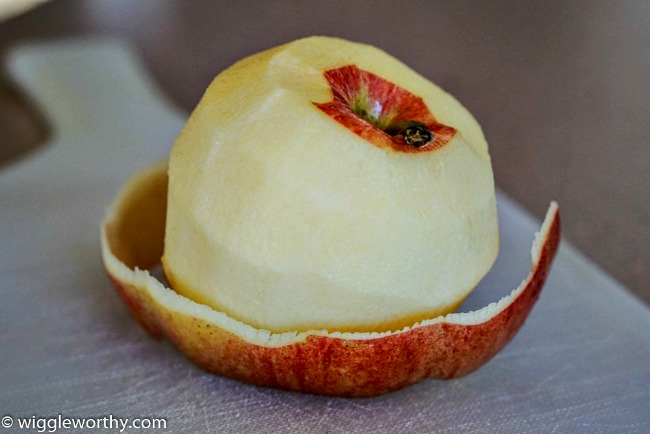
Bananas
Bananas are high in carbohydrates, rich in fiber, and chock full of vitamins and minerals including vitamin B6, vitamin C, manganese and magnesium. They're also an excellent source of potassium.
Adding mashed banana to your homemade dog treat recipes is a healthy (and delicious) way to add all these essential micro-nutrients. Bananas are also fairly high in sugar.
Blueberries
Blueberries are small, but they pack a hefty nutritional punch. Rich in antioxidants including vitamin C, they also contain vitamin and B6, plus a range of minerals including beta-carotene (which the body converts to vitamin A), choline, copper, folate, manganese and potassium.
As with most fruits and veggies, blueberries are also a good source of fiber. Blueberries are powerful antioxidants and studies have shown that they can protect active/working protect from exercise induced oxidative stress You can use fresh or frozen blueberries in your recipes for dog cookies, cakes, frozen treats and more.
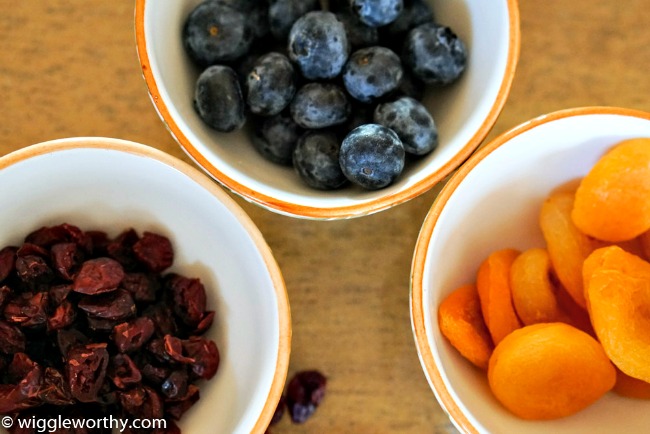
Cranberries
Cranberries add a little tartness to recipes and are a good source of vitamin A, vitamin C, vitamin K, manganese and antioxidants. They also contain healthy fiber. In fact they're a mini super-food! You can add raw, cooked or dried cranberries.
Pineapple
Pineapple is an incredible source of vitamin C and amazingly rich in a variety of other vitamins and minerals especially vitamin B6, magnesium, iron, calcium and vitamin A. It's sweet/tart flavor and juicy fruit adds fiber and taste to dog treat recipes of all kinds.
There are other fruits that you can use in your recipes, including peaches, pears, mangoes, strawberries and raspberries. Some of these are on the 'not safe' list simply because their skin/seeds/pit/stems/leaves are dangerous, but the flesh of the fruit is fine.
Fruit that is NOT safe for dogs to eat
These seven fruits are dangerous for your dog:
- Cherries*
- Currants
- Grapes
- Persimmons
- Raisins
- Rhubarb
- Tomatoes*
* The pits, stem and leaves of cherries and tomotoes are poisonous to dogs, but the actual flesh isn't toxic. However it can cause digestive upset or inflammation, so cherries and tomatoes as a whole are not suitable for dogs to eat.
Citrus fruits can cause digestive upset, or inflammation, if eaten in large quantities, the skin and seeds contains oils which aren't safe for dogs:
- Grapefruit
- Lemons
- Limes
- Oranges
There are some fruits which are generally safe to be enjoyed by your dog, but certain parts of the fruit (usually the pit/seeds/skin need to be kept out of his mouth:
- Apricots - the pit is poisonous
- Mangoes - the pit is poisonous. Remove skin.
- Peaches - the pit is poisonous
- Pineapple - spiky skin and core is choking hazard
- Plums - flesh is high in sugar, pit can cause choking or gut obstruction
Apples are a healthy choice for dogs, both fed raw and as part of a dog treat recipe, but the apple seeds are toxic (they contain cyanide, as do the pits of the fruits listed above). Make sure you don't use apple seeds or the core in your treats!
Which Vegetables Are Good In Dog Treats
There are LOTS of vegetables which can be used in homemade dog treat recipes. They come in a variety of sizes, textures, colors and flavors. Each one is a combination of macro and micro nutrients which are essential to the proper functioning of your dog's body and brain.
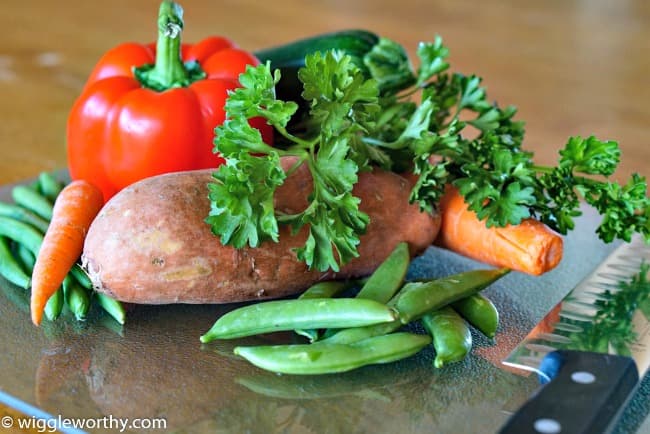
As with fruits, there are some vegetables which are NOT safe, or are even poisonous, to dogs. You need to avoid those completely.
So, what vegetables can be used in homemade dog treat recipes? Let's take a look...
Bell Peppers
Bell peppers (red, yellow and green) are nutrient dense and safe to feed to your dog. All colors of bell peppers are loaded with vitamin C, they also contain vitamin B6, iron, magnesium and vitamin A. Yellow and green peppers contain trace amounts of calcium. Red peppers have the highest concentration of beta-carotene (which converts to vitamin A in the body), while yellow peppers contain the highest amount of vitamin C.
Red bell peppers are also the sweetest and these are the ones I'm most likely to use in my dog treat recipes. Followed by yellow bell peppers coming in second choice. Never feed your dog hot, spicy or 'chili' peppers because your dog's digestive system can't tolerate them and it could cause diarrhea, vomiting or dehydration, any/all of which could be severe.
Bell pepper skins can be tough, and difficult for dogs to digest so it's a good idea to skin the peppers before adding the flesh to your treats.
Carrots
Carrots feature in loads of dog treat recipes, and for good reason. They're low in calories, high in fiber and rich in beta-carotene (which the body converts into vitamin A). Carrots also contain vitamin B6, vitamin K and potassium.
Grated carrots add crunch and color (and of course great nutrition) to your dog treat recipes and their flavor is so versatile that it pairs well with a huge variety of other ingredients. Carrots are a great choice for both sweet or savory treats.
Green Beans
Fresh green beans are full of vitamins and minerals including vitamins A, B6, C and K, calcium and iron. They're low in calories, high in fiber and a good source of plant-based protein. You can steam green beans to add to your recipes, or use fresh green beans in frozen dog treats for a little extra, natural crunch.
Peas
All kinds of peas are suitable for dogs to eat, that includes garden peas, snap peas and snow peas. Garden peas are the best choice for adding to dog treat recipes which are being baked. Snow peas or snap peas can be used in frozen dog treats as they're naturally crunchy anyway.
Although they're small, peas are big, nutritionally speaking. They're loaded with minerals like iron, magnesium, potassium and zinc, vitamins A and C, plus B vitamins and antioxidants like lutein. Dogs with kidney problems should not eat peas.
Pumpkin
Pumpkin is a super healthy, low fat, and versatile, ingredient for dog treats. It's fiber rich and can help both firm up loose stools, or relieve constipation, it's pretty clever that way.
Pumpkin is nutrient dense and a great source of vitamins, minerals and antioxidants. It contains vitamins B2, C and E, and is extremely rich in beta-carotene (which the body converts into vitmain A). Also contains iron, manganese and potassium. Pumpkin's water content is high too, so it adds extra fluids to your recipes too.
You can use homemade pumpkin puree or buy canned pumpkin (NOT the pumpkin pie filling, just pure pumpkin, and organic if possible). Pumpkin seeds are also a safe and tasty dog treat addition. Make sure to clean and roast the seeds before using them.
Sweet Potato
Sweet potatoes are delicious, fat-free, nutrient dense vegetables which are very versatile and make a great addition to both sweet and savory dog treat recipes.
Because sweet potatoes are high in fiber they are good for the digestive system, and have more beta-carotene (which provides the body with vitamin A) than any other vegetable. They're also high in antioxidants and rich in vitamin C, manganese, vitamin B6, potassium, copper, niacin, magnesium and other essential nutrients.
You can bake or steam your sweet potato before adding it to your recipes, or try using a dehydrator or just your oven set at a low temperature (around 250F), to make delicious, nutritious, chewy sweet-potato-slice dog treats.
Zucchini (Summer Squash or Courgette)
Zucchini squash is a low carb, low calorie vegetable with a high water content and a low glycemic index. All that alone makes it sound healthy, but there's more.
Zucchini is high in a range of essential vitamins and minerals including vitamin C, vitamin B6, vitamin K, beta-carotene, magnesium and iron. It's also an antioxidant powerhouse.
Like sweet potatoes and pumpkin, zucchini tastes great in both sweet and savory dog treat recipes while adding nutritious moisture to whatever you make.
Vegetables that are NOT safe for dogs to eat
Avocados should not be given to dogs at all. The skin, pit and leaves all contain persin which is toxic to dogs. Although the flesh contains less persin there is enough to make Avocado's poisonous. Avoid them.
Mushrooms. The regular mushrooms at the grocery store are not likely to pose a danger to your dog, but they also don't need to eat them. Wild mushrooms of all kinds are poisonous to dogs, so it's best to just cross mushrooms off your ingredient list.
Onions. Onions (including chives, spring onions and leeks) are poisonous to dogs. All parts of an onion are dangerous. Do not add them to your treats in any form.
Garlic. Although a medium to large sized dog would have to eat a LOT of garlic for it to cause him harm, there is the potential for that harm. Smaller dogs may not need to ingest much for it to cause damage, and some dogs are more sensitive than others to garlic's toxicity. Don't use garlic in your recipes to be safe.
Using Homemade Juice & Pulp in Dog Treats
If you're like me and enjoy making juices at home you can use both the pulp and the juice from a variety of fruits and vegetables in your dog treat recipes. That way your dog can get the nutrient benefits too.
One of the easiest ways to do this is to make frozen pupsicles from a mixture of both pulp and juice.
You can also mix an egg and half a cup of flaxseed or rolled oats with two cups of pulp and bake at approx. 2ooF to make dog biscuits.
And finally, homemade juice (not store bought unless it's unsweetened) can be substituted for water, milk or broth in any recipe you choose. Because juice is usually thicker you may need to increase the liquid measurement in the recipe, or add a little water as well.
Just always be sure that you choose dog-friendly fruits and veggies for the juices you're sharing with your best friend. Some of my favorites include:
- Apples (REMOVE pips first)
- Blueberries
- Carrots
- Cucumber
- Kale
- Pineapple
- Spinach
You Might Also Like These pages...
- Home
- Dog Treat Ingredients
- Fruits & Vegetables for Dog Treat Recipes
